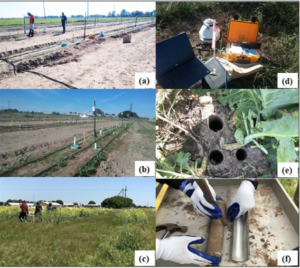
A view of the experiment site: within a few days (a), after several weeks (b), and (c) a few months after its start. (d) LI-COR carbon-dioxide sampling system, (e) locations of soil samples that were used in soil physical, chemical and organic carbon content analyses, and (f) processing of soil sample samples collected in the upper part (0 to 15 cm) and the lower part (16 to 30 cm) of the root zone.
April 27 – Dr. Ram Ray studied the carbon emission from the soil at PVAMU Research Farm along with his colleagues, Drs. Griffin Richard, Ali Fares, Almoutaz Elhassan, Ripendra Awal, Selamawit Woldesenbet, and Eric Risch. The team of researchers investigated the effect of organic amendments and climatic parameters such as rain and air temperature on spatial and temporal distributions of soil carbon dioxide (SCO2) across Texas during two growing seasons of Collard Greens. Their findings have made significant contributions to the soil and plant science, ecology, remote sensing, and Greenhouse Gas Emission (GHG) communities along with the Nature Research Scientific Journal.
Abstract
Vegetated land surfaces play an important role in determining the fate of carbon in the global carbon cycle. However, our understanding of the terrestrial biosphere on a global scale is subject to considerable uncertainty, especially concerning the impacts of climatic variables on the carbon cycle. Soil is a source and also a sink of CO2 exchange and helps in carbon sequestration. Agricultural management practices influence soil water dynamics, as well as carbon cycling by changing soil CO2 emission and uptake rates. The rate of soil CO2 emission varies for different crops and different organic amendments. The major goal of this study was to assess the impacts of the type and rate of organic amendment on soil CO2 emission in a collard greens crop grown in the southeast Texas environment. Thirty-six plots were developed to grow collard greens on Prairie View A&M University’s Research Farm. Three types of organic amendments (Chicken manure, Dairy manure, and Milorganite), at four levels of application (0, 168, 336, and 672 kg N/ha) were used and replicated three times. Each organic amendment type was applied to nine randomly selected plots. Three random plots were used as a control in each row. We measured daily soil CO2 emission for the first two weeks and every other day in a week during the experiment. We evaluated the effects of organic amendments and the application rates on soil CO2 emission for collard greens during two growing seasons. The results showed higher the application rates for each organic amendment, higher the CO2 emissions from the soil. The results also showed higher cumulative CO2 emissions for the soils amended with chicken manure and milorganite, but lowest for the soils amended with dairy manure. This field experiment and analyses help better understand the temporal and spatial variations of soil CO2 emission, and also help to develop best management practices to maximize carbon sequestration and to minimize soil CO2 emissions during the growth periods of collard greens under changing temperatures using different organic amendments, and application rates.
To read the entire article on Dr. Ray’s research, please visit
HTML Version: https://www.nature.com/articles/s41598-020-62267-6
PDF Version: https://www.nature.com/articles/s41598-020-62267-6.pdf
Ram L. Ray, Ph.D., P.E.
Research Scientist
Raray@pvamu.edu
(936) 261-5094

